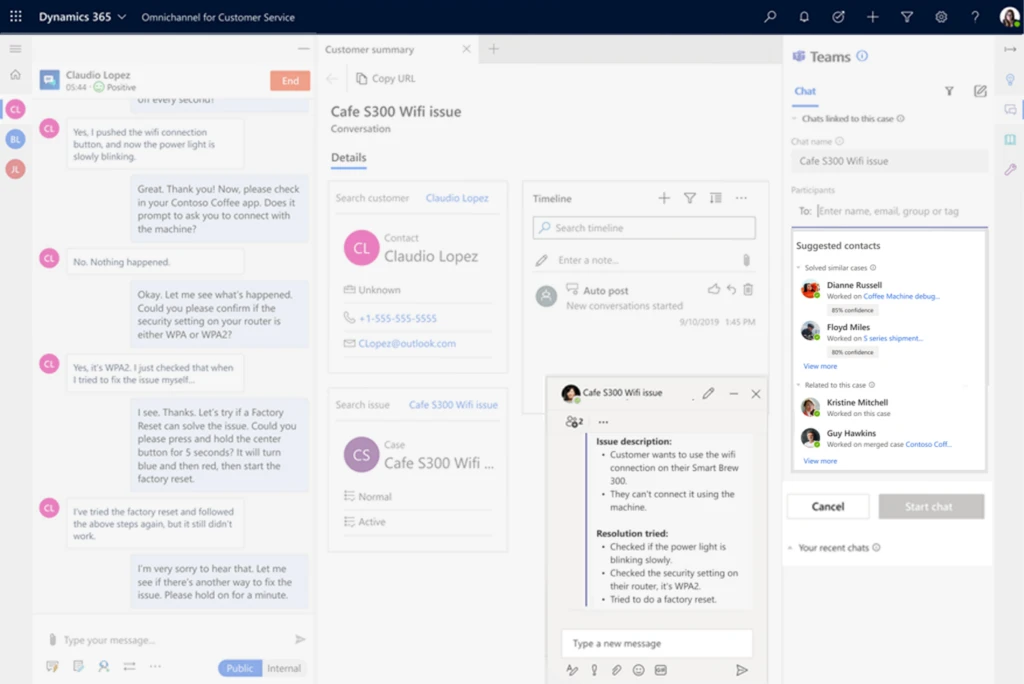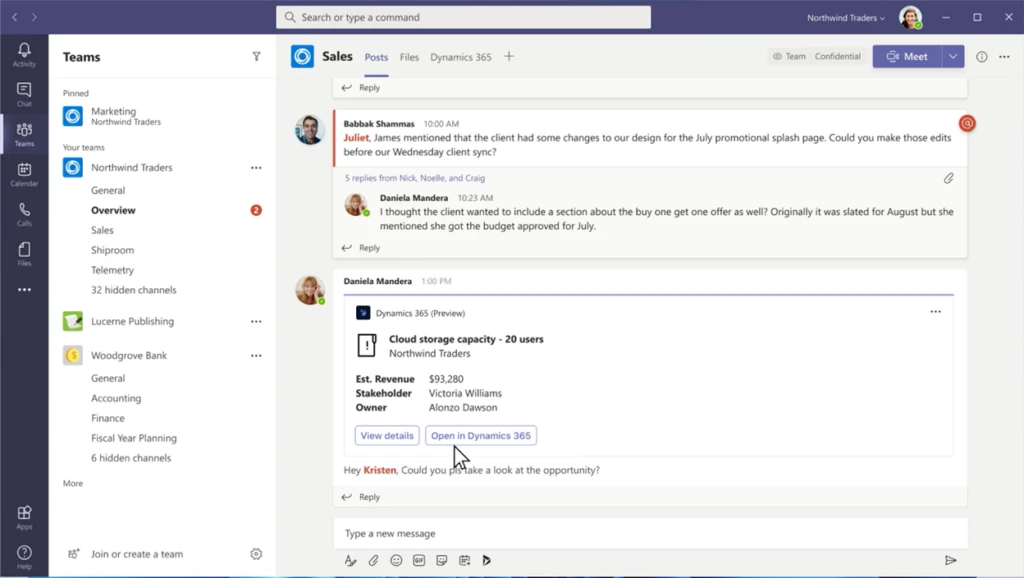
How Context IQ improves collaboration in Dynamics 365
At Microsoft Ignite last November, we announced Context IQ, a set of capabilities across our Microsoft portfolio that intelligently connects you with the information you need, where and when you need it. Today, we’re sharing how products that leverage Context IQ are redefining work, creating new ways to collaborate, and democratizing access to and the use of information to benefit the organization and ultimately, the customer.
With this April 2022 release of Microsoft Dynamics 365, the focus continues to be on two critical departments within organizations: customer service and sales. Locating information is a pressing issue as salespeople and customer service agents continue to work across local and cloud systems in collaborative environments. Employees are consistently frustrated updating the same information across multiple platforms and having to jump from app-to-app to reference information and complete tasks.
It is with great pleasure that I share the latest Context IQ capabilities leveraged in Dynamics 365 Customer Service and Dynamics 365 Sales. We’re excited about the cross-organization collaboration features with Dynamics 365 and Microsoft Teams, including customer support swarming, embedded Teams chat within Dynamics 365, unified Teams meetings experiences with Dynamics 365 data, and sharing and updating Dynamics 365 records within Teams. These new capabilities will continue to nurture and expand collaboration within the workplace, empowering employees with the information and insights they need to thrive, be more productive, collaborate in the flow of work, and focus more time on the parts of the job that matter most.
Seamlessly collaborate in the flow of work
- Customer support swarming in Dynamics 365 Customer Service
- Teams chat embedded within Dynamics 365 Sales and Dynamics 365 Customer Service
- Unified Teams meetings experience for Dynamics 365 Sales and Dynamics 365 Customer Service users
- Share and update Dynamics 365 Sales and Dynamics 365 Customer Service records within Teams
Customer support swarming
Transform an entire organization into a unified customer service team by bringing together the right talent to effectively resolve complex cases with customer support swarming. Using smart rules, customer support swarming suggests skills and invites the best relevant experts to resolve an agent’s issue. When joining the swarm, relevant skills are displayed identifying the expertise of each swarm participant. Participants with key relationships are included as each swarm member brings a unique perspective and skillset to resolve the issue at hand. Powered by Teams, customer service agents and subject matter experts can swarm cases in the applications they’re accustomed to using, including Customer Service workspace and Teams. Customer support swarming can save an agent time by bringing together the right resources to quickly resolve complex issues while maintaining focus on the customer.
Preview available in Dynamics 365 Customer Service in April.

To learn more, visit the documentation: Teams Integration.
Teams chat embedded within Dynamics 365
As we announced last November at Ignite, you can collaborate with stakeholders directly from within Dynamics 365 Sales and Dynamics 365 Customer Service. This capability allows you to use Dynamics 365 data as an organizing layer for your Teams collaboration activity and link chats to Dynamics 365 records, such as sales opportunities and service cases, for convenient access for all participants.
- AI-suggested contacts for Teams-based collaboration. When agents initiate a Teams chat on an active case or a service conversation, they’re proactively provided with suggestions of other agents who’ve resolved similar cases.
- AI-generated conversation summary. Using intelligence, a conversation summary is automatically produced when an agent has a customer conversation and wants to collaborate with other teammates using embedded Teams.
Preview available in Dynamics 365 Sales and Dynamics 365 Customer Service in April.

To learn more, visit the documentation: Teams Integration.
Unified Teams meetings experience for Dynamics 365 and Dynamics 365 Customer Service users
The number of virtual meetings has grown significantly over the past two years, as has the value in having the customer context available for all meeting participants. Starting in April users will now be able to create and join Teams meetings from Dynamics 365 and be able to view and edit records within the context of the Teams meetings interface. Having context of the customer conveniently within the Teams meeting interface reduces the need to switch between apps during the conversation, empowering the user to be more engaged with the customer and increasing the likelihood the customer relationship management (CRM) record receives timely updates. Additionally, Conversational Intelligence capabilities will be integrated into the Teams meeting experience providing sellers with AI-guided suggestions that improve customer engagement.
Preview available in Dynamics 365 Sales and Dynamics 365 Customer Service in April.

Share and update Dynamics 365 records within Teams
Teams chat and channels have become an increasingly common place for Dynamics 365 users to discuss customer records. Sellers and agents can easily share, reference, and edit Dynamics 365 records in the context of Teams chats and channels, eliminating the need to switch context or applications to get work done. Other participants of the conversation can see the summary details and choose to view or edit the record right from within Teams or Dynamics 365, whatever their preference. Users will also be able to select posts within Teams and quickly add to Dynamics 365 as an activity update to a specific record.
Preview available in Dynamics 365 Sales and Dynamics 365 Customer Service in April.

To learn more, visit the documentation: Easily edit a Dynamics 365 record within a Microsoft Teams conversation.
Better together
We’re continuing our investment in Context IQ, connecting users with the information they need, when they need it. The power of Context IQ brings you new ways to collaborate and enhance user productivity—whether your team resides in the same city, country, or hemisphere. We’re committed to improving employee experiences by securing real-life solutions to the everyday challenges of locating and updating siloed information across disparate systems and applications.
To learn more, visit the Dynamics 365 and Microsoft Teams webpage.
If you’re not already a Dynamics 365 customer, visit the Dynamics 365 webpage and sign up for a free trial.



